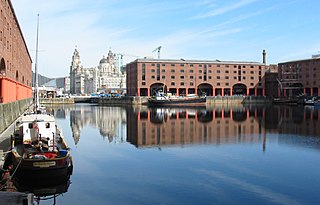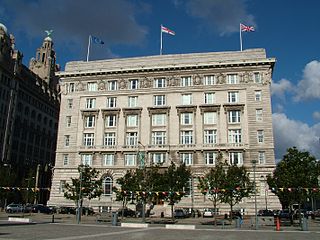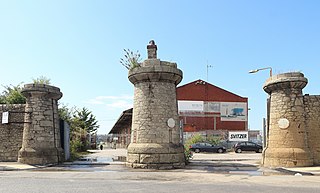Related Research Articles

Liverpool is a city and metropolitan borough in Merseyside, England, with a population in 2019 of 498,042, making it the tenth-largest English district by population. Liverpool's metropolitan area is the fifth-largest in the United Kingdom, with a population of 2.24 million.

A World Heritage Site is a landmark or area with legal protection by an international convention administered by the United Nations Educational, Scientific and Cultural Organization (UNESCO). World Heritage Sites are designated by UNESCO for having cultural, historical, scientific or other form of significance. The sites are judged to contain "cultural and natural heritage around the world considered to be of outstanding value to humanity". To be selected, a World Heritage Site must be a somehow unique landmark which is geographically and historically identifiable and has special cultural or physical significance. For example, World Heritage Sites might be ancient ruins or historical structures, buildings, cities, deserts, forests, islands, lakes, monuments, mountains, or wilderness areas. A World Heritage Site may signify a remarkable accomplishment of humanity, and serve as evidence of our intellectual history on the planet, or it might be a place of great natural beauty. As of July 2021, a total of 1,120 World Heritage Sites exist across 167 countries. With 55 selected areas each, China and Italy are the countries with the most sites on the list.

A listed building, or listed structure, is one that has been placed on one of the four statutory lists maintained by Historic England in England, Historic Environment Scotland in Scotland, Cadw in Wales, and the Northern Ireland Environment Agency in Northern Ireland.

The Royal Albert Dock is a complex of dock buildings and warehouses in Liverpool, England. Designed by Jesse Hartley and Philip Hardwick, it was opened in 1846, and was the first structure in Britain to be built from cast iron, brick and stone, with no structural wood. As a result, it was the first non-combustible warehouse system in the world. It was known simply as the Albert Dock until 2018, when it was granted a royal charter and had the honorific "Royal" added to its name.

The Cunard Building is a Grade II* listed building in Liverpool, England. It is located at the Pier Head and along with the neighbouring Royal Liver Building and Port of Liverpool Building is one of Liverpool's Three Graces, which line the city's waterfront. It is also part of Liverpool's former UNESCO designated World Heritage, the Maritime Mercantile City.

The Pier Head is a riverside location in the city centre of Liverpool, England. It was part of the former Liverpool Maritime Mercantile City UNESCO World Heritage Site, which was inscribed in 2004 but revoked in 2021. As well as a collection of landmark buildings, recreational open space, and a number of memorials, the Pier Head was the landing site for passenger ships travelling to and from the city.

The Port of Liverpool Building is a Grade II* listed building in Liverpool, England. It is located at the Pier Head and, along with the neighbouring Royal Liver Building and Cunard Building, is one of Liverpool's Three Graces, which line the city's waterfront. It is also part of Liverpool's UNESCO-designated World Heritage Maritime Mercantile City.

Bramley-Moore Dock is a semi-derelict dock on the River Mersey in Liverpool, England, and part of the Port of Liverpool. The dock is located in the northern dock system in Liverpool's Vauxhall area, and is connected to Sandon Half Tide Dock to the north and Nelson Dock to the south. Jesse Hartley was the architect, and the dock opened in 1848.

Stanley Dock is a dock on the River Mersey, England, and part of the Port of Liverpool. It is situated in the Vauxhall area of Liverpool and is part of the northern dock system. The dock is connected to the Leeds and Liverpool Canal to the east and Collingwood Dock to the west.

The Port of Liverpool is the enclosed 7.5 miles (12.1 km) dock system that runs from Brunswick Dock in Liverpool to Seaforth Dock, Seaforth, on the east side of the River Mersey and the Birkenhead Docks between Birkenhead and Wallasey on the west side of the river. The port was extended in 2016 by the building of an in-river container terminal at Seaforth Dock, named Liverpool2. The terminal can berth two 14,000 container Post-Panamax ships.

Liverpool Waters is a large scale £5.5bn development that has been proposed by the Peel Group in the Vauxhall area of Liverpool, Merseyside, England. The development will make use of a series of presently derelict dock spaces at Central Docks. From 2004 to 2021 much of the docks involved in the development were part of the Liverpool Maritime Mercantile City, a UNESCO World Heritage Site, but the development of these docks were cited as a reason for the revocation of Liverpool's World Heritage status. This is an area north of Liverpool's historic Pier Head. It is the sister programme of the Wirral Waters project. Since 2012 the two projects have enjoyed enterprise zone status, together forming the Mersey Waters Enterprise Zone.

The Liverpool Maritime Mercantile City was, between 2004 and 2021, a UNESCO designated World Heritage Site in Liverpool, England. It comprised six locations in the city centre of Liverpool including the Pier Head, Albert Dock and William Brown Street, and included many of the city's most famous landmarks.

Victoria Tower is a Grade II listed Gothic Revival clock tower located alongside Salisbury Dock in Liverpool, England. Positioned among the two river entrance gates to the Salisbury Dock itself, the tower acted as an aid to ships by providing both an accurate time and also warning of impending meteorological changes.

The designation of World Heritage Site is a highly prestigious honor. Such a designation bestows not only honor, but also economic benefit, as it enhances tourism.

The Prudential Assurance Building is a Grade II listed, Victorian Gothic revival style office building located on Dale Street in the centre of Liverpool, England.

There are over 2500 listed buildings in Liverpool, England. A listed building is one considered to be of special architectural, historical or cultural significance, which is protected from being demolished, extended or altered, unless special permission is granted by the relevant planning authorities. Of the listed buildings in Liverpool, 27 are classified as Grade I listed and are recognised as buildings of outstanding architectural or historic interest. The following list provides information on all the Grade I listed buildings in the city.
Bramley-Moore Dock Stadium is a proposed football stadium for Everton F.C. on Bramley-Moore Dock in Vauxhall, Liverpool, England. The stadium is due to open for the start of the 2024-25 Premier League season, replacing Goodison Park.

George's Dock Building is a Grade II listed building in Liverpool, England. It is located at the Pier Head on the city's waterfront. It is part of Liverpool's UNESCO designated World Heritage Maritime Mercantile City. It was built in the 1930s in the Art Deco style. Occupants of the office space include, Merseytravel, The Liverpool City Region Combined Authority, Mersey Tunnels staff and The Mersey Tunnels Police. It also houses ventilation machinery for the Queensway Tunnel and the Mersey Tunnels Tour Offices.
References
- 1 2 "Listed buildings" (PDF). Liverpool City Council. Archived from the original (PDF) on 27 September 2013. Retrieved 22 July 2013.
- ↑ "Grade I listing for synagogue". BBC. 3 March 2008. Retrieved 11 July 2009.
- ↑ "Liverpool stripped of Unesco World Heritage status". BBC News. 21 July 2021. Retrieved 21 July 2021.
- ↑ Hughes (1999), p11
- ↑ Hughes (1999), p10
- ↑ "Listed buildings". Liverpool City Council. Archived from the original on 17 October 2008. Retrieved 21 September 2008.
- ↑ "Historic Britain: Liverpool". HistoricBritain.com. Retrieved 13 July 2009.
- ↑ "Merseyside Facts". The Mersey Partnership. 2009. Archived from the original on 19 September 2007. Retrieved 13 July 2009.
- ↑ "Heritage map for changing city". BBC News . 19 March 2002. Retrieved 11 July 2009.
- ↑ ""Liverpool - Maritime Mercantile City"" . Retrieved 26 May 2008.




